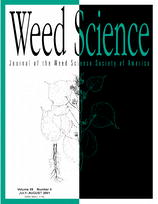Field experiments were conducted in 1996 and 1997 to evaluate the efficacy of combined cultural and biological weed control for management of Canada thistle in conservation tillage soybean production. For cultural control, we used a highly weed-competitive soybean variety (cv. ‘Kato’). The biological control agent was the phytopathogenic bacterium Pseudomonas syringae pv. tagetis (PST). The application of PST reduced Canada thistle survivorship, height growth, and seed production, although these reductions were usually less than those resulting from bentazon application. Only bentazon application resulted in significant reduction of biomass of Canada thistle plants that survived all season. These results suggest the value of PST for management of Canada thistle in conservation tillage systems due to its negative effects on survival, growth, and reproduction. However, the weed-competitive soybean variety did not affect Canada thistle performance differently than a less competitive variety used for comparison, and there was no indication of synergy between the effects of the two control methods.
Nomenclature: Bentazon; imazethapyr; Canada thistle, Cirsium arvense (L.) Scop. CIRAR; soybean, Glycine max (L.) Merr. ‘Kato’, ‘Evans’; Pseudomonas syringae pv. tagetis.





